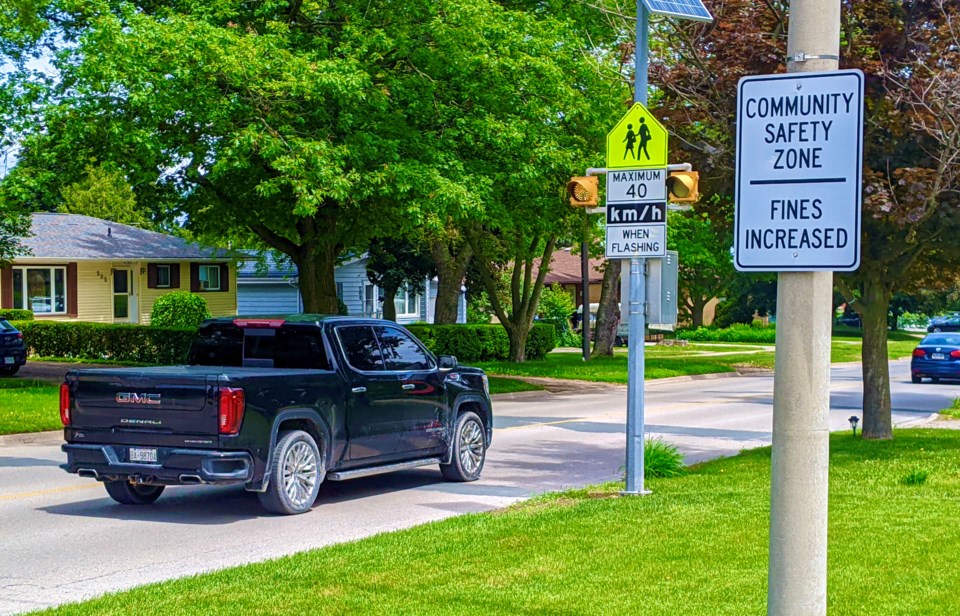Barrie’s lead-footed drivers could have another reason to ease up on the gas.
Councillors will consider a motion Monday night that city staff be authorized to move forward with an automated speed enforcement (ASE) program in school zones and community safety zones, with a spending limit of $300,000 this year.
This would involve leasing two mobile cameras, which would be rotated throughout the city, hiring a new senior transportation technologist, Ontario Transportation Ministry (MTO) licence plate hookup costs, Barrie’s portion of the shared costs associated with a joint processing centre or sworn provincial offences officers who review the camera images and issue tickets, traffic signs; postage and startup membership costs.
Deputy Mayor Barry Ward said speeding has been an ongoing concern since he was elected in 2000.
“From my first day on council, complaints about traffic generally and speeding specifically have always been near the top in terms of phone calls and emails from residents and comments at town halls and when knocking on doors,” he said. “It appears to be a problem on just about every street in Barrie and, from discussions I’ve had with my colleagues around the country at conferences, every municipality in Canada.”
Once the ASE program is operational, city staff anticipate 880 violations per month, based on two camera locations and relocated between wards every two months.
Peter Leon, communications co-ordinator with Barrie police, said its traffic unit laid approximately 8,600 speeding tickets throughout the city last year. He said the city's police department supports initiatives that promote community and road safety.
Automated speed enforcement is a system that uses a camera and a speed measurement device to detect and capture images of vehicles travelling faster than the posted speed limit in school or community safety zones. These types of charges are the responsibility of the vehicle owner and not the driver. They must currently be processed through a Provincial Offences (POA) Court office.
The ticket contains a digitized copy of the image and an enlargement of the plate portion. It is mailed to the registered licence-plate holder within 30 days of the offence, outlining next steps and the cost of the associated fine. The registered licence-plate holder gets the ticket, whether they were driving the vehicle at the time. There is a monetary fine for those convicted, but demerit points are not issued and the registered owner’s driving record isn’t affected.
“There is no magic bullet,” Ward said about speeding prevention. “It is an issue which has to be addressed with multiple measures. We’ve taken many steps, including the introduction of community safety zones with their lower speed limits and flashing lights.”
He said the city has also introduced traffic-calming measures such as speed cushions and road diets — which is narrowing a street to slow down traffic.
“In my mind, (it's) the single most effective thing we can do,” Ward said. “In Barrie, one of the most common road-diet techniques is changing a four-lane road, such as Livingstone (Street), to two lanes in each direction, a turning lane and bike lanes on each side. They have proven very effective in getting traffic to obey speed limits.
“We are trying to introduce design measures in new subdivisions to address the problem before it develops. Road diets can also be narrowing the road width when the subdivision is built," he added.
Ward says he sees ASE as a legitimate deterrence to speeding.
“I see automated speed enforcement as yet another tool in our efforts to reduce speeding,” he said. “It’s unfortunate provincial rules will only allow it in community safety zones near schools at this time, but at least it is a start.
“I think it will make some drivers think twice about speeding in all areas because they will know there is automated speed enforcement in the city, especially after they receive their first ticket.”
Ward said the staff report indicates this program could pay for itself and any excess revenue could be used for further initiatives, such as more automated speed enforcement units, red-light cameras or traffic calming measures.
“It’s hard to see a downside to the program,” he said.
School zones are designated road areas near a school, and typically occur within 150 metres of the front of a school and have reduced speed limits during specific periods of the day. City council policy mandates a 40 kilometre an hour posted speed limit in front of elementary schools, as well as for roadways where – due to their geometric design – there is an increased probability of danger when a car drives at 50 km/h or a higher speed limit.
On major roads where there are elementary schools, a ’40 km/h when flashing’ speed limit is in effect. Barrie has these speed limits – which follow varying time schedules – in 23 elementary school locations.
Community safety zones are established by municipal council through a bylaw, and cover road areas where there is a higher risk to, or concern for, drivers, pedestrians, cyclists and/or others who share the space. Highway Traffic Act fines, including speeding, are doubled in community safety zones and many community safety zones are located close to schools. Barrie has more than 75 sections of road designated as community safety zones in accordance with the city's community safety zones bylaw.



